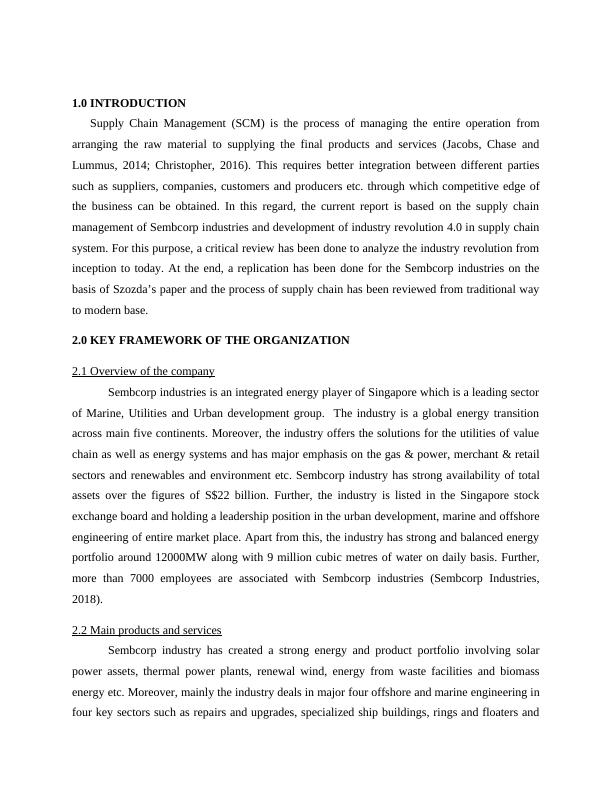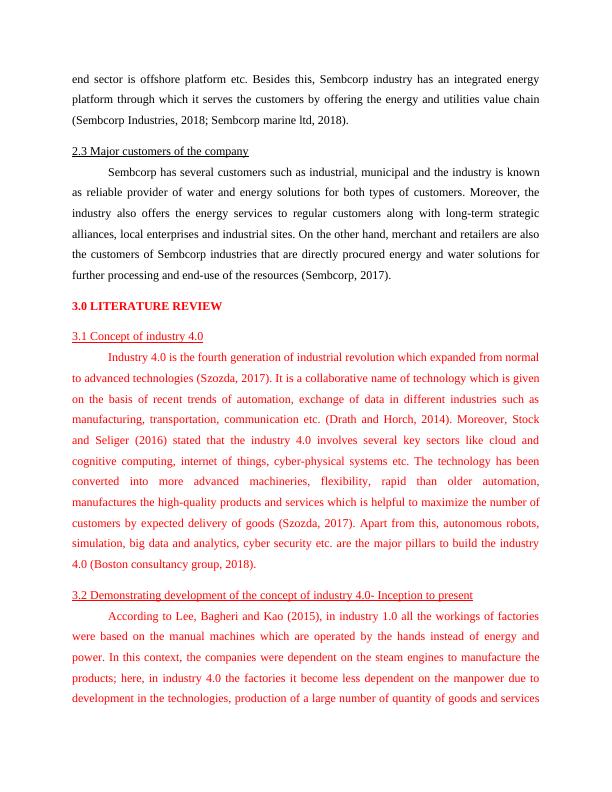Report on Managing Operations and the Supply Chain
Added on 2021-10-14
13 Pages3471 Words125 Views
Managing Operations and the Supply
Chain
Chain

Table of Contents
1.0 INTRODUCTION................................................................................................................1
2.0 KEY FRAMEWORK OF THE ORGANIZATION..................................................................1
2.1 Overview of the company......................................................................................................1
2.2 Main products and services...................................................................................................1
2.3 Major customers of the company..........................................................................................2
3.0 LITERATURE REVIEW..........................................................................................................2
3.1 Concept of industry 4.0..........................................................................................................2
3.2 Demonstrating development of the concept of industry 4.0- Inception to present................2
4.0 REPLICATING SZOZDA’S CASE STUDY...........................................................................5
5.0 CONCLUSION..........................................................................................................................8
6.0 REFERENCES..........................................................................................................................9
List of figures
Figure 1: Development of industry 1.0 to industry 4.0....................................................................3
Figure 2: Phases of industry revolution...........................................................................................4
Figure 3: Traditional supply chain of Sembcorp industries.............................................................6
Figure 4: New supply chain after industry 4.0................................................................................7
1.0 INTRODUCTION................................................................................................................1
2.0 KEY FRAMEWORK OF THE ORGANIZATION..................................................................1
2.1 Overview of the company......................................................................................................1
2.2 Main products and services...................................................................................................1
2.3 Major customers of the company..........................................................................................2
3.0 LITERATURE REVIEW..........................................................................................................2
3.1 Concept of industry 4.0..........................................................................................................2
3.2 Demonstrating development of the concept of industry 4.0- Inception to present................2
4.0 REPLICATING SZOZDA’S CASE STUDY...........................................................................5
5.0 CONCLUSION..........................................................................................................................8
6.0 REFERENCES..........................................................................................................................9
List of figures
Figure 1: Development of industry 1.0 to industry 4.0....................................................................3
Figure 2: Phases of industry revolution...........................................................................................4
Figure 3: Traditional supply chain of Sembcorp industries.............................................................6
Figure 4: New supply chain after industry 4.0................................................................................7

1.0 INTRODUCTION
Supply Chain Management (SCM) is the process of managing the entire operation from
arranging the raw material to supplying the final products and services (Jacobs, Chase and
Lummus, 2014; Christopher, 2016). This requires better integration between different parties
such as suppliers, companies, customers and producers etc. through which competitive edge of
the business can be obtained. In this regard, the current report is based on the supply chain
management of Sembcorp industries and development of industry revolution 4.0 in supply chain
system. For this purpose, a critical review has been done to analyze the industry revolution from
inception to today. At the end, a replication has been done for the Sembcorp industries on the
basis of Szozda’s paper and the process of supply chain has been reviewed from traditional way
to modern base.
2.0 KEY FRAMEWORK OF THE ORGANIZATION
2.1 Overview of the company
Sembcorp industries is an integrated energy player of Singapore which is a leading sector
of Marine, Utilities and Urban development group. The industry is a global energy transition
across main five continents. Moreover, the industry offers the solutions for the utilities of value
chain as well as energy systems and has major emphasis on the gas & power, merchant & retail
sectors and renewables and environment etc. Sembcorp industry has strong availability of total
assets over the figures of S$22 billion. Further, the industry is listed in the Singapore stock
exchange board and holding a leadership position in the urban development, marine and offshore
engineering of entire market place. Apart from this, the industry has strong and balanced energy
portfolio around 12000MW along with 9 million cubic metres of water on daily basis. Further,
more than 7000 employees are associated with Sembcorp industries (Sembcorp Industries,
2018).
2.2 Main products and services
Sembcorp industry has created a strong energy and product portfolio involving solar
power assets, thermal power plants, renewal wind, energy from waste facilities and biomass
energy etc. Moreover, mainly the industry deals in major four offshore and marine engineering in
four key sectors such as repairs and upgrades, specialized ship buildings, rings and floaters and
Supply Chain Management (SCM) is the process of managing the entire operation from
arranging the raw material to supplying the final products and services (Jacobs, Chase and
Lummus, 2014; Christopher, 2016). This requires better integration between different parties
such as suppliers, companies, customers and producers etc. through which competitive edge of
the business can be obtained. In this regard, the current report is based on the supply chain
management of Sembcorp industries and development of industry revolution 4.0 in supply chain
system. For this purpose, a critical review has been done to analyze the industry revolution from
inception to today. At the end, a replication has been done for the Sembcorp industries on the
basis of Szozda’s paper and the process of supply chain has been reviewed from traditional way
to modern base.
2.0 KEY FRAMEWORK OF THE ORGANIZATION
2.1 Overview of the company
Sembcorp industries is an integrated energy player of Singapore which is a leading sector
of Marine, Utilities and Urban development group. The industry is a global energy transition
across main five continents. Moreover, the industry offers the solutions for the utilities of value
chain as well as energy systems and has major emphasis on the gas & power, merchant & retail
sectors and renewables and environment etc. Sembcorp industry has strong availability of total
assets over the figures of S$22 billion. Further, the industry is listed in the Singapore stock
exchange board and holding a leadership position in the urban development, marine and offshore
engineering of entire market place. Apart from this, the industry has strong and balanced energy
portfolio around 12000MW along with 9 million cubic metres of water on daily basis. Further,
more than 7000 employees are associated with Sembcorp industries (Sembcorp Industries,
2018).
2.2 Main products and services
Sembcorp industry has created a strong energy and product portfolio involving solar
power assets, thermal power plants, renewal wind, energy from waste facilities and biomass
energy etc. Moreover, mainly the industry deals in major four offshore and marine engineering in
four key sectors such as repairs and upgrades, specialized ship buildings, rings and floaters and

end sector is offshore platform etc. Besides this, Sembcorp industry has an integrated energy
platform through which it serves the customers by offering the energy and utilities value chain
(Sembcorp Industries, 2018; Sembcorp marine ltd, 2018).
2.3 Major customers of the company
Sembcorp has several customers such as industrial, municipal and the industry is known
as reliable provider of water and energy solutions for both types of customers. Moreover, the
industry also offers the energy services to regular customers along with long-term strategic
alliances, local enterprises and industrial sites. On the other hand, merchant and retailers are also
the customers of Sembcorp industries that are directly procured energy and water solutions for
further processing and end-use of the resources (Sembcorp, 2017).
3.0 LITERATURE REVIEW
3.1 Concept of industry 4.0
Industry 4.0 is the fourth generation of industrial revolution which expanded from normal
to advanced technologies (Szozda, 2017). It is a collaborative name of technology which is given
on the basis of recent trends of automation, exchange of data in different industries such as
manufacturing, transportation, communication etc. (Drath and Horch, 2014). Moreover, Stock
and Seliger (2016) stated that the industry 4.0 involves several key sectors like cloud and
cognitive computing, internet of things, cyber-physical systems etc. The technology has been
converted into more advanced machineries, flexibility, rapid than older automation,
manufactures the high-quality products and services which is helpful to maximize the number of
customers by expected delivery of goods (Szozda, 2017). Apart from this, autonomous robots,
simulation, big data and analytics, cyber security etc. are the major pillars to build the industry
4.0 (Boston consultancy group, 2018).
3.2 Demonstrating development of the concept of industry 4.0- Inception to present
According to Lee, Bagheri and Kao (2015), in industry 1.0 all the workings of factories
were based on the manual machines which are operated by the hands instead of energy and
power. In this context, the companies were dependent on the steam engines to manufacture the
products; here, in industry 4.0 the factories it become less dependent on the manpower due to
development in the technologies, production of a large number of quantity of goods and services
platform through which it serves the customers by offering the energy and utilities value chain
(Sembcorp Industries, 2018; Sembcorp marine ltd, 2018).
2.3 Major customers of the company
Sembcorp has several customers such as industrial, municipal and the industry is known
as reliable provider of water and energy solutions for both types of customers. Moreover, the
industry also offers the energy services to regular customers along with long-term strategic
alliances, local enterprises and industrial sites. On the other hand, merchant and retailers are also
the customers of Sembcorp industries that are directly procured energy and water solutions for
further processing and end-use of the resources (Sembcorp, 2017).
3.0 LITERATURE REVIEW
3.1 Concept of industry 4.0
Industry 4.0 is the fourth generation of industrial revolution which expanded from normal
to advanced technologies (Szozda, 2017). It is a collaborative name of technology which is given
on the basis of recent trends of automation, exchange of data in different industries such as
manufacturing, transportation, communication etc. (Drath and Horch, 2014). Moreover, Stock
and Seliger (2016) stated that the industry 4.0 involves several key sectors like cloud and
cognitive computing, internet of things, cyber-physical systems etc. The technology has been
converted into more advanced machineries, flexibility, rapid than older automation,
manufactures the high-quality products and services which is helpful to maximize the number of
customers by expected delivery of goods (Szozda, 2017). Apart from this, autonomous robots,
simulation, big data and analytics, cyber security etc. are the major pillars to build the industry
4.0 (Boston consultancy group, 2018).
3.2 Demonstrating development of the concept of industry 4.0- Inception to present
According to Lee, Bagheri and Kao (2015), in industry 1.0 all the workings of factories
were based on the manual machines which are operated by the hands instead of energy and
power. In this context, the companies were dependent on the steam engines to manufacture the
products; here, in industry 4.0 the factories it become less dependent on the manpower due to
development in the technologies, production of a large number of quantity of goods and services

End of preview
Want to access all the pages? Upload your documents or become a member.
Related Documents
Impact of Industry 4.0 on Supply Chain Managementlg...
|16
|2868
|55
Analysis of Siemens Organisationlg...
|14
|2401
|233
Strategic Marketing Evaluationlg...
|14
|4622
|2
ExxonMobil Business Strategy Analysislg...
|19
|4990
|350